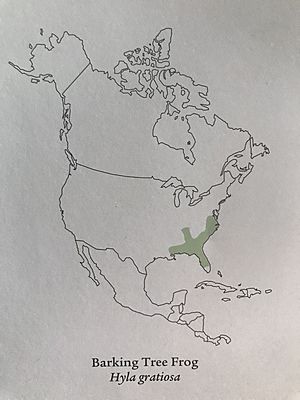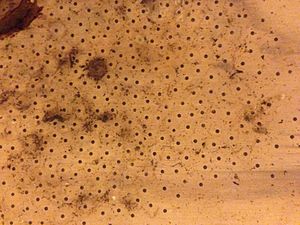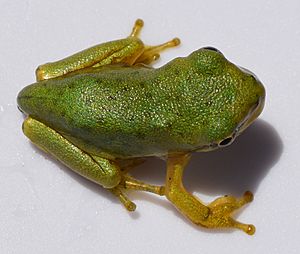Barking tree frog facts for kids
Quick facts for kids Barking tree frog |
|
|---|---|
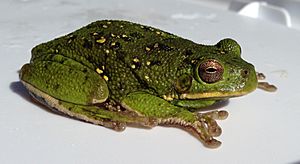 |
|
| Conservation status | |
| Scientific classification | |
| Synonyms | |
|
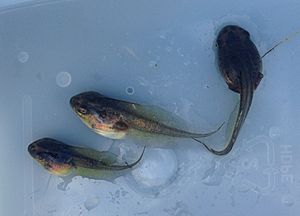
The barking tree frog (scientific name: Dryophytes gratiosus) is a type of tree frog. It gets its name from its loud, barking call. These frogs live only in the southeastern United States.
Contents
Where Do Barking Tree Frogs Live?
You can find barking tree frogs from Delaware all the way down to southern Florida. They also live in eastern Louisiana. Most of them live near the coast.
Sometimes, you might find small groups of them in places like Maryland, Kentucky, and Tennessee. In 1957, a temporary group was even found in New Jersey!
What Do Barking Tree Frogs Look Like?
The barking tree frog is the biggest native tree frog in the United States. It can grow to be about 5 to 7 centimeters (2 to 3 inches) long.
These frogs can be many different colors. They might be bright green, dull green, brown, yellow, or gray. But they are easy to spot because they have dark, round marks on their backs. These marks can even seem to disappear and reappear!
Their skin is thick and feels leathery, which is different from other American frogs. Their skin color can change quickly depending on the light, time of day, temperature, or what's around them. Barking tree frogs have brown, gold, and black eyes. They also have big, round pads on their toes to help them climb. Male frogs have a large throat sac that puffs out when they call.
How Do Barking Tree Frogs Behave?
Barking tree frogs are famous for their very loud, barking calls. Males also make a repeating single-syllable call to attract mates. They often call together with other frogs.
When it's hot, these frogs like to burrow into the sand. They also spend a lot of time high up in trees, especially during the day when they are less active.
Finding a Mate
Female barking tree frogs choose their mates based on the male's call. They listen for certain sounds to pick the best male. Males who arrive at breeding ponds earlier in the night have a better chance of finding a mate.
Females often choose males with louder and higher-pitched calls. These sounds usually mean the male is bigger. Females use a special trick called "triangulation" to find males. This helps them figure out where a male is and how far away he is.
Where Do Barking Tree Frogs Live? (Habitat)
Adult barking tree frogs usually live in trees or bushes. They can also burrow deep into mud and logs. This helps them stay safe from animals that might want to eat them.
For breeding, these frogs need shallow ponds. These ponds should have open areas or be full of grasses. They also need some open water for laying eggs.
How Do Barking Tree Frogs Breed?
Barking tree frogs breed in water, but they lay their eggs on land. Breeding usually happens over two or three months. The exact months depend on where the frogs live. For example, in Kentucky, they breed from mid-June to late July. In Florida, they breed from March to August.
Male frogs often call from the surface of shallow water, especially among plants. After mating, both male and female frogs move to higher grasses. Females can lay a lot of eggs at once, sometimes between 1,500 and 4,000!
When the eggs hatch, tiny tadpoles come out. Tadpoles are the baby form of amphibians, like frogs, and they have tails. These tadpoles can grow to be almost 5 centimeters (2 inches) long.
Are Barking Tree Frogs Endangered?
Good news! The barking tree frog is not considered endangered. As of March 2019, the ICUN Red List says they are of "Least Concern." This means there are plenty of them around.
See also
 In Spanish: Hyla gratiosa para niños
In Spanish: Hyla gratiosa para niños



